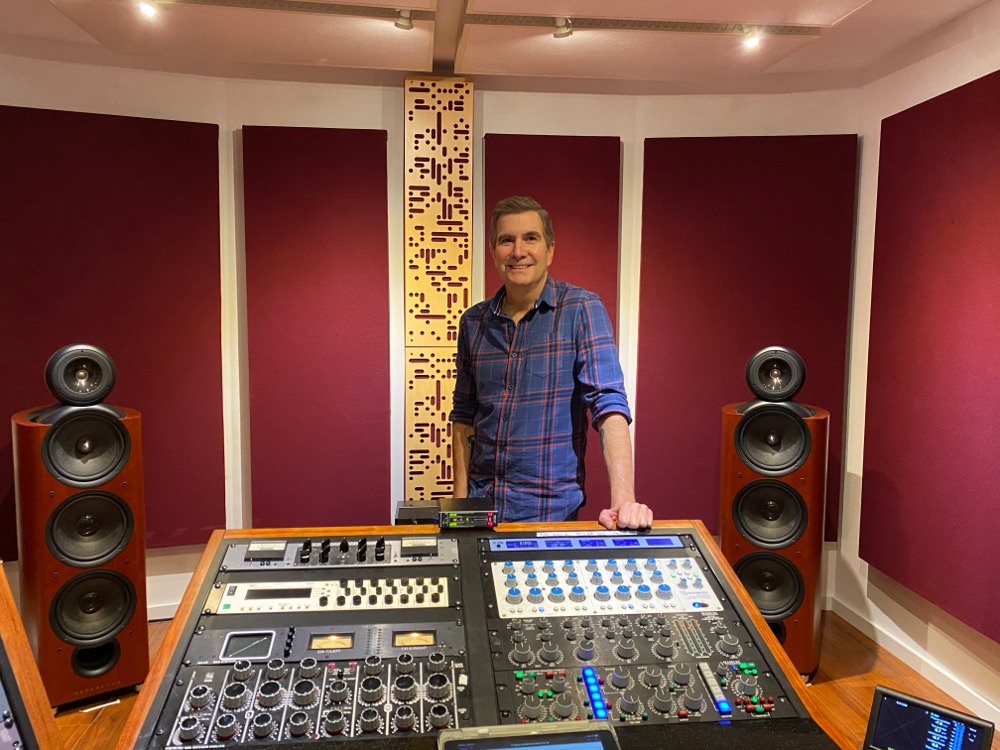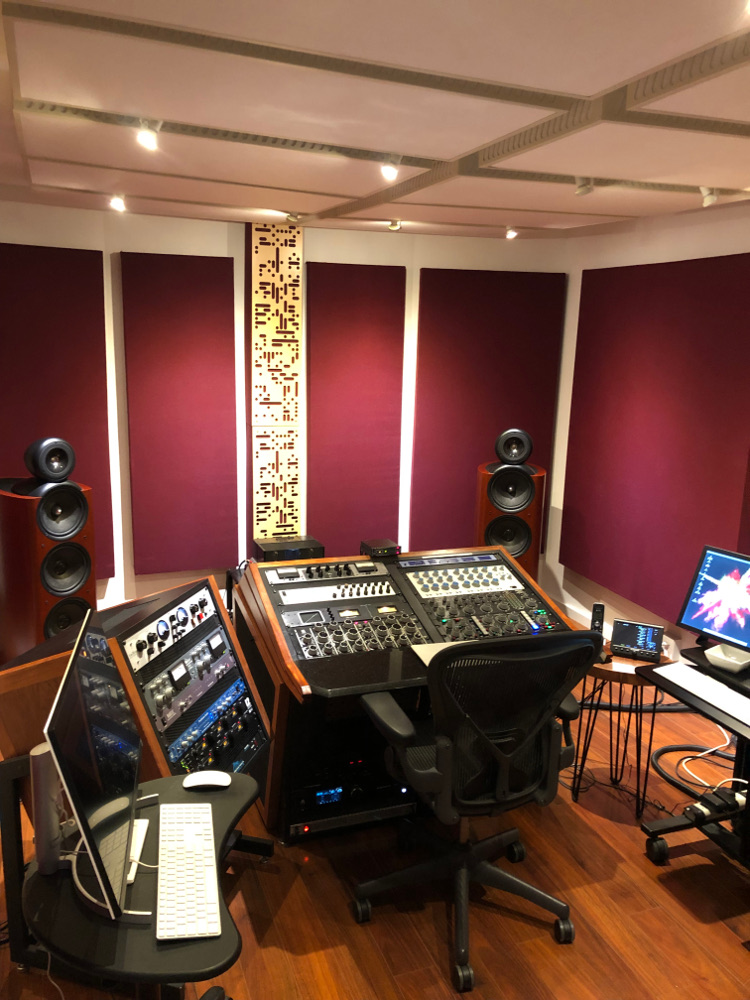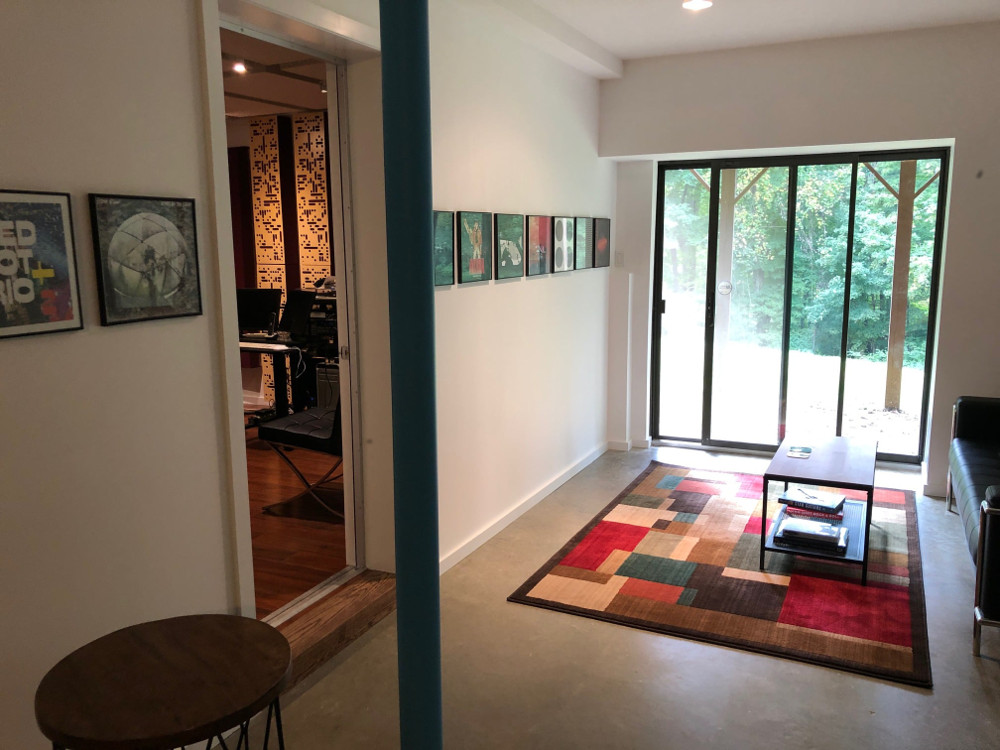Mastering for Dolby Atmos Upstate: Joe Lambert’s New Viewpoint
The busier a mastering engineer is, the more they can expect to sit still in the sweet spot. So why is Joe Lambert a man on the move?
His workload isn’t the issue: Joe Lambert Mastering had a heavy summer of stereo and Dolby Atmos mastering projects, with no sign of an autumn letup. It’s that Lambert has had to change studios more often than he’d like in his career. With his latest mastering suite stop, however, he’s confident that he’s arrived home – literally.
That’s because JLM has moved to the upstate NY hamlet of Cortlandt Manor, about an hour north of New York City, where his new Crossley Acoustics-designed studio is conveniently located in his house. He had previously found accommodating landlords at his former location in Jersey City, which served as his trusty mastering HQ for six years.
After a few years in Jersey City, however, Lambert’s perspective started to change. Always keen to buy a building, he started to seriously question the thousands he was paying each month in rent. Then COVID showed up, making attended sessions at JLM obsolete for over a year. Stacked on top of that: The cold truth that NYC felt like it was missing the core element that had drawn Lambert there two decades-plus before.
“The reason that I moved to New York to get into the music industry – those things do not exist there anymore,” Lambert relates. “The (recording) infrastructure isn’t there. There was a reason that I and so many people that came before me needed to be there. And those reasons are mostly gone.
“Now that I’ve moved to Cortlandt Manor, I’ve been very pleasantly surprised at how many people are still attending sessions. Every week people are coming up, and that’s on top of how many musicians already live in the area. There are people that I’ve worked with for years who’ve never attended, and now they’re like, ‘Oh, you’re close. I’m going to come to the session now.’”
Throughout his career, Lambert has continued to build on a huge Grammy-nominated discography of major label and indie artists. Just a short list includes Sondre Lerche, The Juan Maclean, Jake Clemons, Camper Van Beethoven, LCD Soundsystem, Victory Boyd, Thievery Corporation, Dirty Projectors, Moby, The National, Lindsey Stirling, Stevie Van Zandt, Sharon Van Etten, Animal Collective, Deerhunter, Of Montreal, Third Coast Percussion, Stephen Sondheim, Ian Hunter, Faye Webster, Angel Olsen, and Maya Hawke.
On the Atmos side, recent JLM projects include Steve Aoki HiROQUEST: Genesis, Sofi Tukker Wet Tennis, Julia Jacklin Pre Pleasure, Giolí and Assia Fire Hell and Holy Water, and Fitz Head Up High (of Fitz and The Tantrums).
How to Master for Dolby Atmos: The Learning Curve
Besides now being in the neighborhood with many of his clients, there’s a bigger reason why JLM has seen an uptick in demand. It started with Apple Music’s release of iOS 14 in 2020, which supported spatial audio and gave anyone with AirPods Pro easy access to surround sound experiences.
Then Apple upped the ante in June, 2021 when it announced Spatial Audio with support for Dolby Atmos. That meant that Apple Music would automatically play immersive Dolby Atmos tracks on all AirPods and Beats headphones with an H1 or W1 chip, plus on the built-in speakers in the latest versions of iPhone, iPad, and Mac. Specially curated Dolby Atmos playlists and a commitment to constantly adding new Atmos tracks into Apple Music, as well as “personalized spatial audio” in the just-released iOS 16, keeps increasing the public appetite for surrounding sound.
Predictably, record labels gave mixers a mandate to catch up. Atmos-ready mix rooms, either built that way from the ground up or retrofitted, have been proliferating quickly to allow artists and mixers to create immersive 7.1.4 mixes (see the SonicScoop feature on Jeff Ellis for a look at his L.A. Atmos mixing setup). With Apple making it easy for people to experience spatial audio in their earbuds – as opposed to past attempts at surround that required expensive home theaters or high-end automotive systems – the public appetite for spatial audio is real and growing.
Once Atmos mixes are completed, of course, they must be mastered. Lambert committed himself to learning the format, and word soon spread that he had the prowess to master immersive audio. Hence his many late nights and weekends throughout the summer of 2022.
“Atmos projects take a lot more time, there’s a lot more going on, and there’s a learning curve with it as well,” Lambert says. “Throughout the whole industry – the mix engineers, artists, the labels, myself – we’re all learning as we go and figuring out what works best. I’m starting to do at least an Atmos record a week, and it’s growing from there.”
The reason for the increased time requirements of Atmos mastering start with the vastly increased track count. “Obviously, if you’re mastering a stereo track, it’s just that: left and right, and the gear and room have been designed for generations to work that way,” he notes. “With Atmos you may have 128 distinct tracks at times, and they can be arranged differently. They can be arranged in beds, objects, or a mixture of the two. How they’re arranged make the difference as to how I can treat them as a mastering engineer.
“You’ve got all these different tracks to deal with, and then there’s just more rules that go along with mastering for Atmos loudness. For example, there’s a specific volume you have to work at – you can’t just make it as loud as you want, because you have to stay at or below -18 LUFS (Loudness Units Relative to Full Scale).
“That makes you work harder because you have to actually know what you’re doing. Like I said, you can’t just make it louder and say, ‘It’s better.’ And then there’s the rendering: You’ve got to export the ADM .wav file. You’ve got to export a reference file. It all just takes more time.”
Yet another wrinkle to make mastering for Dolby Atmos its own complex beast is sequencing. Fortunately, new tools have reduced the stress. “Dolby just came out with the Dolby Atmos Album Assembler which is a much more elegant way to sequence,” Lambert says. “If you release a song in Atmos or spatial audio, you have to have a stereo master along with it. You can’t just do one, and that Atmos master must be aligned to the stereo. It has to be the same length – you’ve got time code, and you have to line them all up together. Until very recently, using Pro Tools to sequence was extremely time consuming.”
Evolving to Atmos: It Takes a Village
It may sound like the artists and Atmos mixers get to have all the fun while the mastering engineer does the tedious tasks. However, Lambert notes that advancing the format calls equally on artists, mixers and mastering pros to all make adjustments.
“This is all new to the artists too,” he points out. “Artists are kind of defaulting to wanting the Atmos mix to sound like the stereo mix, because they’ve already signed off on stereo. They know they’re happy with it. But the problem is that if the Atmos mix just sounds like the stereo mix, then the future for spatial isn’t as bright, because you’re not really giving people something different. If it’s not different, I don’t think it will be a format that thrives.
“As time goes on, I’m hoping that the artist will be more comfortable with the Atmos mix being more unique in comparison to the stereo mix. This is a challenge for artists, producers, mix engineers, and labels to make the format unique and worthwhile. If a teenager chooses an Atmos version of a record and it sounds basically the same as stereo, I don’t think that’s going to be a great thing for the format.”
Like many others, Lambert is approaching the growth of Atmos and spatial audio with cautious optimism. “I think it’s a wonderful format with incredible opportunity – it would be great for the music industry if it’s successful,” says Lambert. “We’ve seen this movie before. We’ve seen other formats, like DVD-Audio and others not do well for various reasons. None of those failed because they didn’t sound good. There were just challenges.
“I think Dolby made a very calculated, unique decision to come up with the binaural ability for us to enjoy this in headphones. Because to me it’s all about headphones: The success of this format is completely headphones-based. I don’t care how good it sounds in a room with $100,000 worth of speakers, because 99% of the listening public is never going to experience it that way. Most people listen on headphones. To younger people, a Hi-Fi system means something like a Sonos box.
“So if Atmos doesn’t excite people in headphones, I think it’s dead. But Dolby has put a lot of time, effort, and money into this. We’ve already been living with that mode for a long time with certain television broadcasts and movies, so I’m more optimistic about Atmos than I have been with other immersive formats.”
Mastering in the Manor: Designing the New Studio
In Jersey City, Lambert was able to build out a bigger room than his previous Manhattan and Brooklyn accommodations had allowed. Visitors to the new Cortlandt Manor suite who had attended in the Garden State should feel right at home: for stereo mastering, Lambert’s layout closely mirrors the previous setup. JLM clients continue to be expertly supported by longtime studio manager Diana Zinni.
Lambert’s mastering console sports the same carefully selected gear. It includes one of the first Sontec EQs ever made, a Buzz mastering EQ, Maselec Console, Kef Reference 207 monitors, mastering-grade Manley Vari-Mu, Prism EQ and Compressor, ATR tape machine, and Anamod ATS-1 tape simulator.
All Atmos masters are produced in a separate room outfitted not with a 7.4.1 speaker system, but Focal CEPro headphones and SPL Phonitor SE headphone amp. “I’ve had really great results working in headphones and my clients are very happy,” Lambert says. “If the Atmos continues to go in the right direction, then I’ll make the investment in the monitoring. But even when I do that, I feel like it’s really for my own pleasure. Working in monitors may prove to be easier and faster, but not necessarily better. At the end of the day, I’ve still got to trust the headphones, because that’s how people are going to listen.”
Setting up shop in a place that he owns, Lambert was finally able to spec out a fully floated room – something he was reluctant to put money into for someone else’s real estate. “The last two JLM rooms were really nice, but they weren’t floating,” he says. “When I got into my own home, I was willing to make the investment. This is a fully floated room, and it sounds incredible. There’s just a sound to this room, there’s a quiet to it.”
Lambert’s experience of his suite illuminates what a highly experienced mastering engineer requires from their listening environment. “When I start listening to music on a pair of speakers and I’m comfortable, with the gear set up properly, it’s very quickly apparent to me where things are sitting in the stereo field,” explains Lambert. “The low end just feels right. I’m not guessing. I don’t have to play things super loud to get the balance and punch that I want. Those things make it a lot easier for you to work more efficiently, more confidently for longer periods of time, because your ears aren’t fatigued.
“I’m not noticing things bouncing around the room,” he continues. “I can move around the room and I’m confident of what I’m hearing, that it sounds consistent. I can sit in the back of the room and it sounds almost exactly the same as in my chair. I can’t even tell a difference in the low end – it’s basically the same (everywhere in the room), which is really difficult to achieve.
“Crossley Acoustics were very good that way. We used the golden ratio of getting the room’s width, height, and depth just right. And when that stuff comes together, you don’t have to fight. You don’t have to put an EQ on your speakers to get them to sound right – the sound just falls into place.”
Ears of Experience
In his 2015 SonicScoop interview, Lambert classified his approach to mastering as “serve the song.” Heading into 2023, that music-first philosophy remains the heart of his headspace.
“It’s the same thing,” he confirms. “It’s just always doing what you hear the song needs. The starting point is just to listen and do what will make this song be as enjoyable as possible. That’s the only way I can look at it and do confident work. Artists and producers often will have specific things that they’re concerned about, and obviously, I take all that into consideration. But when I sit down to master a song, I’m just going to listen and react.”
Building steadily on a career that started in 1997, Joe Lambert can feel his mastering skills hitting the next level – a precious professional groove that is the gift of deep experience. “Humbly speaking, I don’t think there’s any question that I’m doing my best work yet, the most consistent work I’ve ever done,” he reflects. “Greg Calbi expressed it really well when he said, ‘Anyone can master one song, but I think I have a really high batting average.’
“I thought that was such a great way to put it. You’re mastering dozens, hundreds, thousands, and ultimately tens of thousands of songs – day after day, week after week, month after month, years after year. I think that’s a big part of why I keep getting busier, doing more work with less revisions than ever. All these things go together.”
— David Weiss is an Editor for SonicScoop.com, and has been covering pro audio developments for over 20 years. He is also the co-author of the music industry’s leading textbook on synch licensing, “Music Supervision, 2nd Edition: The Complete Guide to Selecting Music for Movies, TV, Games & New Media.” Email: david@sonicscoop.com
Please note: When you buy products through links on this page, we may earn an affiliate commission.









